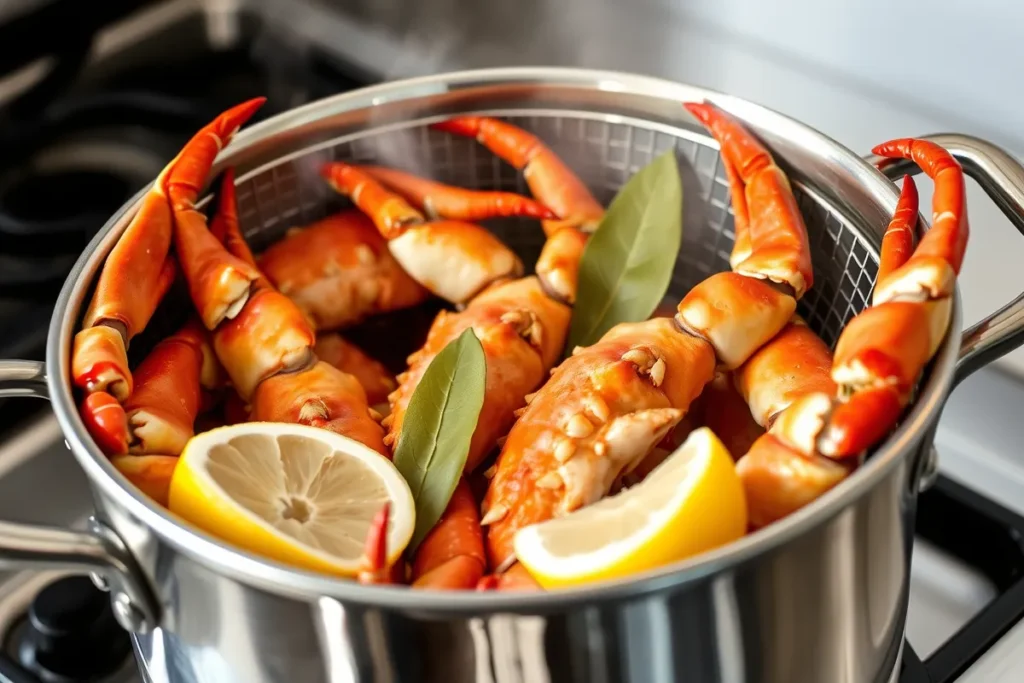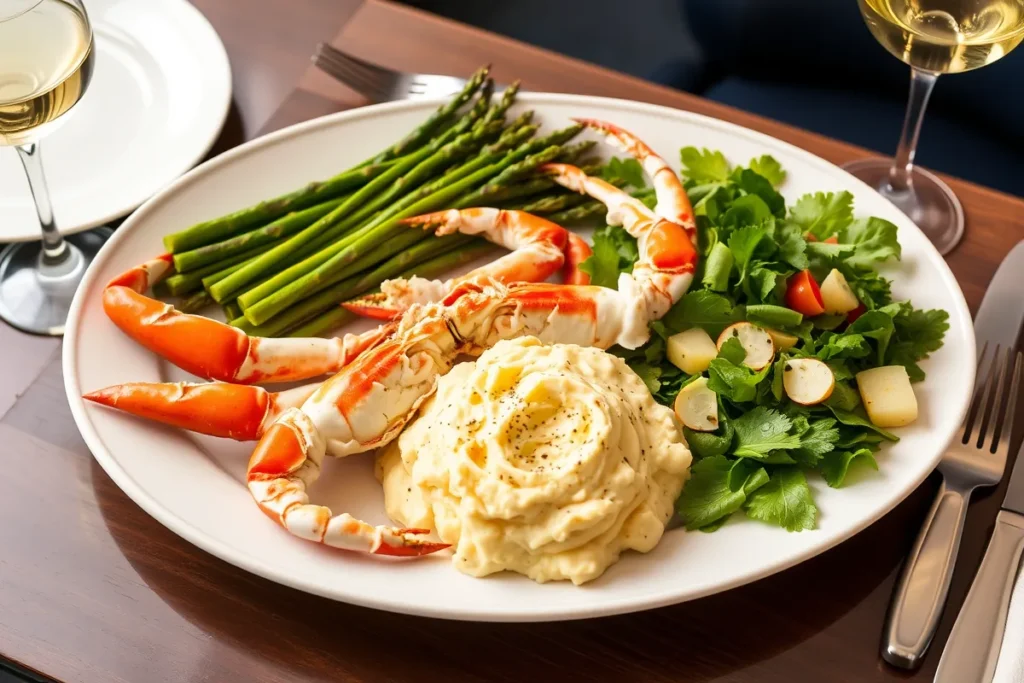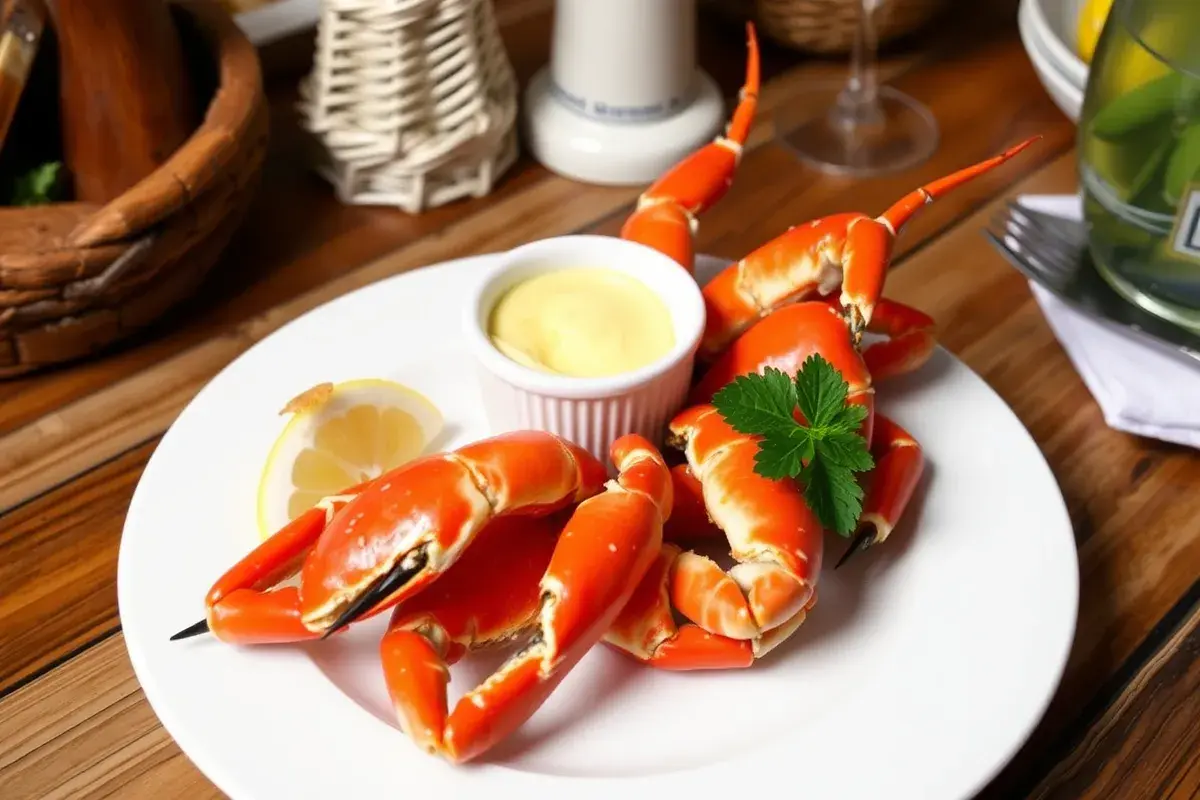Seafood lovers often crave the sweet taste and soft texture of dungeness crab legs. They appeal to the senses with their tender meat and subtle flavor. In addition, they serve as a crowd-pleasing choice for special occasions or casual meals. This guide presents a thorough look into selecting, cooking, and enjoying these savory crab portions. Keep reading for mouthwatering tips, serving ideas, and handy information on storing leftovers.
1. What Are Dungeness Crab Legs?
Dungeness crab legs come from the Dungeness crab, which lives in the Pacific Ocean. These crabs usually reside along the West Coast of North America, from Alaska to California. They are known for their meaty legs and sweet-tasting meat. Each crab has five pairs of legs, and the clusters include connected sections with flavorful meat.
Moreover, these crabs offer a natural and mild taste that appeals to seafood beginners and experts alike. They are often easier to crack open compared to other crustaceans. Therefore, many people reach for these crab legs when making holiday feasts or weekend dinners. The shells tend to be thinner than those of other crabs, so picking out the meat is not too challenging.
2. Why Choose Dungeness Crab Legs?
There are many types of crab sold around the world. However, dungeness crab legs have unique advantages:
- Sweet Flavor: The meat has a pleasant sweetness that does not overwhelm the palate.
- Sustainability: Dungeness crab fisheries often follow guidelines to keep crab populations stable.
- Ease of Preparation: You can buy these legs pre-cooked and frozen, which makes cooking fast.
- Versatile Uses: Boil, steam, bake, or grill them to suit your preference.
In addition, chefs prize them for their firm meat and quick cooking time. They are also a good source of protein and essential nutrients. Many West Coast residents consider them a hometown favorite, but people worldwide appreciate their flavor.
3. Where Do They Come From?
The Dungeness crab’s natural habitat spans the chilly waters of the Pacific Coast. These creatures prefer sandy bottoms where they can feed on small fish and invertebrates. Commercial fisheries focus on sustainable harvesting practices. Therefore, these crab populations remain healthy for future generations. Fishing seasons usually vary by region, but the most common harvest time ranges from late fall to early spring.
This crab variety gets its name from Dungeness, a town in Washington State. Today, the species is available in supermarkets and specialty seafood markets globally. Also, fishmongers often stock pre-cooked crab legs that you can heat quickly at home. That means you can share the taste of the Pacific even if you do not live near the coast.
4. Buying Guide: Tips for Freshness and Quality
Choosing quality dungeness crab legs depends on several factors. Pay attention to the following details when shopping:
4.1. Shell Appearance
- Look for a firm shell with minimal discoloration.
- Shells with bright coloration often indicate freshness.
4.2. Smell
- Fresh crab should smell salty or slightly sweet.
- A strong fishy odor can point to spoiled meat.
4.3. Price
- Crab leg prices can vary by season and region.
- Watch for sales during peak crab harvest periods for cost savings.
4.4. Source
- Many reputable seafood counters list harvest locations.
- Ask about sustainability practices to support responsible fishing.
4.5. Frozen vs. Fresh
- Frozen legs are convenient and keep well.
- Fresh legs may deliver a slightly sweeter taste, but they have a shorter shelf life.
Furthermore, keep an eye out for pre-packed clusters. These bundles often contain intact legs and claws, which is handy if you want a smaller portion. You might also find packages that include the body meat. Some stores label these products as “dungeness crab sections.” They can be a simple option for chowders or salads since the shells hold plenty of tender pieces.
5. Preparing Dungeness Crab Legs for Cooking
Before cooking, thaw your dungeness crab legs if they are frozen. Place them in the refrigerator the night before your meal. This method helps preserve flavor and texture. If you need to thaw them quickly, you can submerge them in cold water for 20 to 30 minutes. Then pat them dry before continuing with any recipe.
Next, you can rinse them under cold water to wash away any debris. Because many crab legs arrive pre-cooked, they only need reheating. However, you can still add spices, herbs, or a splash of citrus to boost flavor.
Many home cooks like to split the shells using kitchen shears. That step allows seasoning to reach the meat directly. It also makes the meat easier to remove after cooking. Additionally, trimming away sharp edges on the legs protects your hands during prep.
6. Cooking Methods for a Tasty Dungeness Crab Legs
Dungeness crab legs lend themselves to multiple cooking styles. Their mild flavor pairs well with dry or wet heat. Below are four popular methods to consider.
6.1. Steaming

Steaming is a popular cooking method for crab legs. It preserves moisture and sweetness in the meat. Follow these steps:
- Fill a pot with about an inch of water or broth.
- Add aromatic ingredients like lemon slices, garlic, or bay leaves.
- Place a steamer basket in the pot.
- Heat on medium until steam builds up.
- Arrange the crab legs in the basket.
- Cover and steam for about 5 to 7 minutes, or until heated through.
Sprinkle fresh herbs or a dash of Old Bay seasoning over the crab after steaming. Therefore, you get a flavor boost without overcomplicating the dish.
6.2. Boiling
Boiling is another straightforward method. This technique produces moist and tender crab legs:
- Bring a large pot of salted water to a rolling boil.
- Carefully place your crab legs into the water.
- Boil for about 4 to 6 minutes.
- Remove with tongs or a large slotted spoon.
- Drain and serve with melted butter.
In addition, feel free to add spices to your water. Cajun seasoning or garlic powder can impart a subtle kick to the crab. However, be careful with salt levels, as crab already holds some natural salinity.
6.3. Baking
Baking is a hands-off approach that works well if you want to prepare side dishes on the stovetop. Follow these simple steps:
- Preheat your oven to 375°F (190°C).
- Place the crab legs on a baking sheet or in a shallow baking dish.
- Cover with foil to trap moisture.
- Bake for about 10 to 12 minutes, or until heated through.
- Serve with drawn butter or a creamy sauce.
Another option is to coat them with a small amount of melted butter and minced garlic. That step helps the meat remain juicy and adds a fragrant aroma.
6.4. Grilling
Grilling infuses a smoky flavor that contrasts well with the sweetness of crab meat. That is why many outdoor gatherings feature grilled dungeness crab legs. Here’s how:
- Preheat your grill to medium-high heat.
- Lightly brush the legs with olive oil.
- Place them on the grill for 5 to 8 minutes.
- Turn them occasionally to prevent burning.
- Remove when the shells show light char marks.
Serve immediately with lemon wedges. In addition, grilled vegetables or corn on the cob make ideal summer side dishes.
7. Sauces and Seasonings for Perfect Dungeness Crab Legs
The right sauce or seasoning can make dungeness crab legs even more appetizing. Common sauces include:
- Drawn Butter: Melted butter with a pinch of salt and garlic.
- Garlic Aioli: Mayonnaise-based sauce mixed with roasted garlic and lemon juice.
- Cocktail Sauce: Ketchup with horseradish, lemon juice, and Worcestershire sauce.
- Spicy Remoulade: A tangy mix of mustard, hot sauce, pickles, and herbs.
For seasoning, consider blends that include paprika, chili powder, or herbs like thyme and oregano. In addition, you can sprinkle fresh parsley or chopped chives on top of the cooked legs for a bright finish.
8. Side Dishes and Meal Pairings

Dungeness crab legs can be part of a light meal or a grand seafood feast. Consider these pairing ideas:
- Classic Surf and Turf: Pair with a grilled steak or roasted chicken.
- Fresh Salads: Crisp greens with vinaigrette complement the rich crab flavor.
- Starches: Rice pilaf, mashed potatoes, or garlic bread soak up juicy drips.
- Roasted Vegetables: Try asparagus, zucchini, or bell peppers for a nutritious side.
Moreover, you can serve them alongside other shellfish like shrimp or clams. This approach creates a seafood boil that pleases many palates.
9. Dungeness Crab Legs Storage and Leftovers
Sometimes you end up with leftover dungeness crab legs. Proper storage keeps them fresh for another meal. Follow these simple tips:
- Refrigeration: Store any cooked leftovers in an airtight container. Use them within two days.
- Freezing: Place excess crab in freezer-safe packaging. This option can extend shelf life for up to three months.
- Reheating: Gently warm leftover legs by steaming or baking them. Avoid overcooking, as the meat can turn rubbery.
Leftovers can turn into crab cakes, soups, or pasta dishes. Therefore, you can save time and still create delicious meals without wasting any meat.
10. Nutrition and Health Benefits
Dungeness crab legs offer high-quality protein and essential minerals like zinc and selenium. They are also low in fat, which fits many dietary goals. Furthermore, they contain omega-3 fatty acids that support overall health. Here are some nutritional highlights:
- Protein: Helps maintain muscle mass and repair tissues.
- Omega-3s: Linked to heart and brain support.
- Vitamins: A source of B vitamins that assist in energy production.
- Minerals: Zinc and selenium support immune function.
However, people with shellfish allergies must be cautious. Also, some enjoy dipping their crab meat in butter, which can add calories. Moderation keeps the meal balanced while letting you savor every bite.
11. Cracking and Extracting Dungeness Crab Legs Meat
Opening dungeness crab legs can be easy with the right method. Use these steps for hassle-free meat removal:
11.1. Twist and Pull
- Grab the leg at the joint and twist gently.
- Pull the leg away from the body or cluster.
11.2. Use Kitchen Shears
- Cut along the length of the shell.
- Be mindful of the sharp edges.
11.3. Remove Cartilage
- Pull out the long, thin cartilage piece if it remains in the meat.
- That piece can be discarded.
11.4. Scoop with a Seafood Fork
- Slide a small fork or pick into the shell to lift out hidden pieces.
11.5. Enjoy the Claws
- Crack the claws with a mallet or nutcracker.
- Extract the claw meat, which is often very sweet.
Therefore, you get the most from each cluster and avoid leaving any tasty morsels behind.
12. Serving Suggestions and Creative Ideas
These suggestions showcase the versatility of dungeness crab legs:
- Crab Tacos: Shred the meat, then mix it with lime juice, chili flakes, and cilantro. Fill soft tortillas with crunchy slaw, and top with a zesty sauce.
- Crab Mac and Cheese: Stir chopped crab into a creamy pasta dish. Sprinkle with breadcrumbs and bake until golden.
- Crab Salad Sandwiches: Combine crab meat, mayo, diced celery, and a dash of lemon pepper. Stuff into toasted rolls or croissants.
- Crab Fried Rice: Sauté garlic, onions, and mixed veggies in a wok. Stir in day-old rice, crab meat, and a splash of soy sauce.
- Crab Omelet: Fold the meat into fluffy eggs with cheese, spinach, and cherry tomatoes.
In addition, many seafood restaurants highlight them as an indulgent appetizer. A small portion of dungeness crab legs can be served with a crisp white wine, such as Sauvignon Blanc or Pinot Grigio. The fresh acidity cuts through the richness of the meat.
13. FAQs
13.1. Which is better, snow crab legs or Dungeness crab?
Snow crab legs are longer and thinner, with a softer shell. They often have a mild briny taste. On the other hand, dungeness crab legs have a sweeter flavor and thicker shells. Many people prefer the firm texture and richer taste of Dungeness crab. However, snow crab is sometimes easier to crack if you want a simpler dining experience.
13.2. Do Dungeness crab legs have a lot of meat?
Yes, dungeness crab legs hold a good amount of meat for their size. The clusters also carry meat in the body section. This portion often rivals the claw meat in sweetness. Therefore, you can expect a satisfying yield from each crab, making them a top choice for seafood lovers.
13.3. Which is better, Dungeness or king crab?
King crab legs offer bigger pieces of meat and a robust flavor. However, dungeness crab legs tend to be sweeter and more tender. Dungeness crabs also cost less in many regions, which can be a deciding factor. If you prefer a milder taste and easier cracking, Dungeness might be a better match.
14. Conclusion
Dungeness crab legs bring the sweet essence of the Pacific Coast to your dinner table. Their tender meat, paired with a choice of cooking methods, means you can adapt them to any meal style. Many appreciate their ease of preparation, as they often come pre-cooked and frozen. In addition, their mild but delicious flavor suits various sauces and side dishes.
Furthermore, they pack valuable nutrients and offer a protein-rich alternative to red meat. Whether you grill them for a backyard feast or steam them for an elegant dinner, dungeness crab legs are a popular seafood treat. Try different recipes to find your personal favorite. Then gather friends and family around the table to share a meal that blends convenience with taste.

